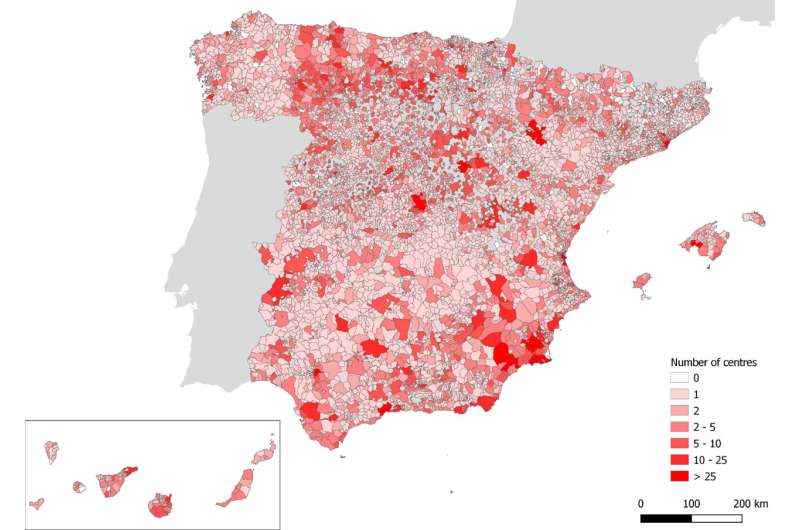This article has been reviewed according to Science X's editorial process and policies. Editors have highlighted the following attributes while ensuring the content's credibility:
fact-checked
trusted source
proofread
Researchers create smart routes to ensure all rural areas have access to health care

The equivalent to the 15-minute city in rural areas is the 45-minute territory. These are areas where the inhabitants can access everything they need for a good quality of life in 45 minutes, either on foot or by bicycle.
Some 85% of Spain's territory is considered to be rural, with an average population density of 17.7 people per square kilometer. In this large and sparsely populated rural Spain, "It's estimated that 9% of municipalities don't meet the 45-minute criterion," said Cristian Castillo Gutiérrez, a member of the Faculty of Economics and Business at the Universitat Oberta de Catalunya (UOC) and a researcher in the Sustainability, Management and Transport (SUMAT) research group.
In order to make a basic service like primary health care more accessible to the rural population, Castillo led a study published in Socio-Economic Planning Sciences involving researchers from the UOC, the Universitat Autònoma de Barcelona (UAB) and the Universitat Politècnica de Valencia (UPV) that used algorithms to create efficient routes for vehicles providing medical care services.
"This means that the population in these areas, which is mostly older people and with little access to public transport, doesn't have to travel to a medical center," explained Castillo. In specific terms, the study uses routing algorithms, which design the most efficient routes according to parameters such as priorities, visit duration and journey distances. The algorithms created can be scaled and customized.
Professor Ángel A. Juan, researcher at the Research Center on Production Management and Engineering (CIGIP) on the Alcoy Campus of the UPV, and Javier Panadero, associate professor in the Department of Computer Architecture and Operating Systems at the UAB, took part in the development of the algorithms and the subsequent computational testing. Together they coordinate the ICSO interuniversity research group, and the Transport and Artificial Intelligence research network.
As Ángel A. Juan explained, "The intelligent algorithms that our research group develops are able to solve complex optimization problems, such as finding the best routes for vehicles or, as is the case with this project, helping to plot routes so that all rural areas can get access to health care."
"This work has been very rewarding, as it offers AI tools to improve access to health care," said Javier Panadero. "It's enabled the existing close collaboration between the three participating universities to strengthen and grow, opening the door to more research in the same line, to continue offering tools that make life easier for people in depopulated parts of Spain."
The article in Socio-Economic Planning Sciences includes a simulation of routing in a rural province. This simulation was performed in Segovia, a province where 11.8% of the municipalities are located more than a 45-minute walk from a primary health care center.
"It's a simulation that can easily be transferred to any other part of Spain," said Castillo, who is an expert in integrated management, operations and logistics systems. "The knowledge in the study is available to any public administrations that want to use it."
Empty Spain
Some 15.9% of Spain's population, or just over 7.5 million people, live in rural areas, according to figures from the Ministry of Agriculture, Fisheries and Food. The definition of rural areas covers municipalities with fewer than 30,000 inhabitants and a population density of less than 100 inhabitants per square kilometer.
On a smaller scale, 4.45 million inhabitants are registered as living in municipalities with fewer than 5,000 inhabitants, and approximately half of them (2.2 million) live in towns and village with a population of under 2,000 inhabitants.
The major depopulation of these rural areas, compared to the large concentrations of population in the urban centers, helps explain "the enormous difficulties faced by the rural population in accessing all the public resources and services necessary to lead a decent life under equal conditions," according to the ministry.
More information: Cristian Castillo et al, Home healthcare in Spanish rural areas: Applying vehicle routing algorithms to health transport management, Socio-Economic Planning Sciences (2024). DOI: 10.1016/j.seps.2024.101828





















